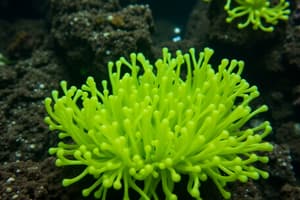Podcast
Questions and Answers
What do algae use to manufacture their own carbohydrate food?
What do algae use to manufacture their own carbohydrate food?
- Oxygen and nitrogen
- Carbon dioxide and water (correct)
- Proteins and oil
- Sunlight and minerals
How do aquatic forms of algae obtain water and carbon dioxide?
How do aquatic forms of algae obtain water and carbon dioxide?
- By absorbing them from the surrounding medium (correct)
- By consuming other organisms
- By breaking down nutrients
- Through photosynthesis
What is the purpose of reproduction in algae?
What is the purpose of reproduction in algae?
- To modify their body structure
- To grow in size
- To increase in number (correct)
- To respond to environmental changes
What type of reproduction is witnessed in all kinds of algae?
What type of reproduction is witnessed in all kinds of algae?
What is the mode of reproduction in unicellular forms of algae?
What is the mode of reproduction in unicellular forms of algae?
What is the result of cell division in multicellular forms of algae?
What is the result of cell division in multicellular forms of algae?
What is the term for the breaking of a filamentous thallus into small portions of living cells?
What is the term for the breaking of a filamentous thallus into small portions of living cells?
What is the term for the process by which a living organism propagates and multiplies the number of its individuals?
What is the term for the process by which a living organism propagates and multiplies the number of its individuals?
What is the process called when a fragment of an organism grows into a new individual under favourable conditions?
What is the process called when a fragment of an organism grows into a new individual under favourable conditions?
What is the function of akinetes in algae?
What is the function of akinetes in algae?
What is the characteristic feature of akinetes?
What is the characteristic feature of akinetes?
What is the purpose of aplanospores?
What is the purpose of aplanospores?
Which type of spore is provided with one or more flagella?
Which type of spore is provided with one or more flagella?
What is the common method of multiplication among algae under favourable conditions?
What is the common method of multiplication among algae under favourable conditions?
What is the characteristic of an aplanospore that is still within the parent wall?
What is the characteristic of an aplanospore that is still within the parent wall?
What is the process by which vegetative cells lose water and contract to form akinetes?
What is the process by which vegetative cells lose water and contract to form akinetes?
What type of zoospores are found in Ulothrix?
What type of zoospores are found in Ulothrix?
What is the purpose of sporangia in some algae?
What is the purpose of sporangia in some algae?
How are exospores produced?
How are exospores produced?
What is the difference between asexual spores produced by meiotic division and those produced by mitotic division?
What is the difference between asexual spores produced by meiotic division and those produced by mitotic division?
Under what conditions does sexual reproduction take place?
Under what conditions does sexual reproduction take place?
What is the term for a plant that produces both male and female gametes in the same individual?
What is the term for a plant that produces both male and female gametes in the same individual?
What is the characteristic of isogamous type of sexual reproduction?
What is the characteristic of isogamous type of sexual reproduction?
What is the difference between anisogamous and oogamous types of sexual reproduction?
What is the difference between anisogamous and oogamous types of sexual reproduction?
What is the characteristic of heterogamous type of sexual reproduction?
What is the characteristic of heterogamous type of sexual reproduction?
What is the term for the male gametes in anisogamous type of sexual reproduction?
What is the term for the male gametes in anisogamous type of sexual reproduction?
What is the characteristic of oogamous type of sexual reproduction?
What is the characteristic of oogamous type of sexual reproduction?
What is the term for the female reproductive body in Rhodophyceae?
What is the term for the female reproductive body in Rhodophyceae?
How many different types of life cycles are present in algae?
How many different types of life cycles are present in algae?
What is the characteristic of anisogamous type of sexual reproduction?
What is the characteristic of anisogamous type of sexual reproduction?
Study Notes
Algae Characteristics
- Algae manufacture their own carbohydrate food from carbon dioxide and water through the agency of sunlight.
- Aquatic forms obtain water and carbon dioxide by osmosis and diffusion, respectively, from the medium in which they grow.
- Aerial forms obtain H2O from the damp substratum and CO2 from the air.
- Algae synthesize oil and proteins from the carbohydrates they manufacture, and the soluble forms of nitrogen and other minerals available in solution in the water in which they grow.
Environmental Factors
- Favorable temperature, suitable light, proper supplies of oxygen, carbon dioxide, and essential elements favor the growth of algae.
Reproduction in Algae
- Algae exhibit three types of reproduction: vegetative, asexual, and sexual reproduction.
Vegetative Reproduction
- Fission: unicellular forms reproduce by vegetative method called fission or cell division, resulting in two daughter cells that separate immediately.
- Fragmentation: multicellular forms with a filamentous thallus reproduce by breaking into small portions of living cells called fragments, which grow into new individuals.
- Akinetes: single-celled resting fragments, specially modified to function as a means of perennation and multiplication, formed either singly or in chains in the vegetative filament.
Asexual Reproduction
- Asexual reproduction is the commonest method of multiplication among algae under favorable conditions.
- Spores involved in asexual reproduction include zoospores, aplanospores, autospores, hypnospores, carpospores, tetraspores, endospores, and exospores.
- Zoospores are the most important kind of asexual spore, provided with one or more flagella and containing a chromatophore, a nucleus, and an eye spot.
Sexual Reproduction
- Sexual reproduction takes place under unfavourable conditions.
- Gametes (male and female) are produced within gametangia.
- The plant may be homothallic (producing male and female gametes in the same individual) or heterothallic (producing male and female gametes in separate individuals).
- Sexual reproduction can be categorized into two types: isogamous and heterogamous.
Isogamous Type
- Both male and female gametes are morphologically similar but differ physiologically.
- This type is common among unicellular algae and considered to be primitive.
Heterogamous Type
- Both male and female gametes differ both morphologically and physiologically.
- Male gametes are usually smaller in size.
- This type can be further categorized into anisogamous and oogamous.
Anisogamous Type
- Both fusing gametes are motile, but the male gametes are comparatively smaller in size and more active.
Oogamous Type
- It is considered the most advanced type of sexual reproduction.
- It is common among the higher algae.
- The male gametes are motile and found in large numbers, whereas the female gametes are non-motile and bigger in size.
Life Cycle in Algae
- Three different types of life cycles exist, depending on when meiosis occurs, the type of cells produced, and if there is more than one free-living stage present in the life cycle.
Studying That Suits You
Use AI to generate personalized quizzes and flashcards to suit your learning preferences.
Description
Learn about how algae produce their own food through photosynthesis, obtaining necessary resources from their environment. Understand their ability to synthesize oil, proteins, and more.




